Welcome to our free classical music site

Do you write about classical music? Are you a blogger? Want to team up with Classical Connect? Send us a message, let's talk!

Do you write about classical music? Are you a blogger? Want to team up with Classical Connect? Send us a message, let's talk!
November 14, 2016. Paul Hindemith. One of the most important composers of the 20th century, Paul Hindemith was born on November 16th of 1895 in Hanau, near Frankfurt. Paul’s father, a painter, was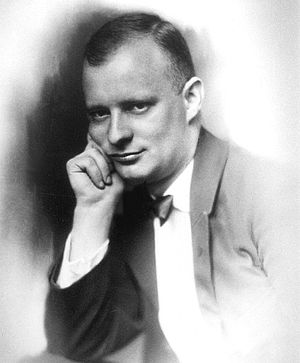 a music lover and insisted that his children study music: Paul played violin, his sister studied the piano and their younger brother – the cello. Some year later they would play in public as the “Frankfurt Children’s Trio,” with their father sometimes accompanying them on the zither. Paul attended the Frankfurt Conservatory, concentrating in violin and later, in 1912, adding classes in composition (his first composition teacher was Arnold Mendelssohn, a great-nephew of Felix Mendelssohn). While at the conservatory, Hindemith wrote his first compositions, which were technically strong, very romantic (just the opposite of what would become his later style) but not terribly inventive. In 1914 he joined the orchestra of the Frankfurt Opera and soon became the concertmaster. Three years into the war he was conscripted; he served mostly in a military band but at the end of the war spent some time in the trenches. He remembered how in March of 1918 he and his fellow musicians were playing Debussy’s String Quartet when it was announced on the radio (sic!) that Debussy had died. When after the war he returned to Frankfurt, he switched from the violin to the viola; he continued playing in the opera orchestra and with the Rebner Quartet.
a music lover and insisted that his children study music: Paul played violin, his sister studied the piano and their younger brother – the cello. Some year later they would play in public as the “Frankfurt Children’s Trio,” with their father sometimes accompanying them on the zither. Paul attended the Frankfurt Conservatory, concentrating in violin and later, in 1912, adding classes in composition (his first composition teacher was Arnold Mendelssohn, a great-nephew of Felix Mendelssohn). While at the conservatory, Hindemith wrote his first compositions, which were technically strong, very romantic (just the opposite of what would become his later style) but not terribly inventive. In 1914 he joined the orchestra of the Frankfurt Opera and soon became the concertmaster. Three years into the war he was conscripted; he served mostly in a military band but at the end of the war spent some time in the trenches. He remembered how in March of 1918 he and his fellow musicians were playing Debussy’s String Quartet when it was announced on the radio (sic!) that Debussy had died. When after the war he returned to Frankfurt, he switched from the violin to the viola; he continued playing in the opera orchestra and with the Rebner Quartet.
The period starting around 1920 was very productive one; that was also the time when Hindemith found his voice, dropping romanticism in favor of expressionism. An interesting example is his sexually charged one-act opera, Sancta Susanna (the protagonist, a nun, gives in to her erotic fantasies; Satan seems to be very active). The performance created a scandal; it is said that in Hamburg, attendees were required to pledge, in writing, to not cause a disturbance. Here it is, in its entirety – Susanna is just 25 minutes long. The American soprano Helen Donath, who had worked mostly in Germany, is Susanna; The Berlin Radio Symphony Orchestra is conducted by Gerd Albrecht.
We are used to thinking of Hindemith as a cerebral composer of complex, contrapuntal music. Many compositions from the early 1920s are very different: very expressive, even wild. Grove Music Dictionary gives us a wonderful quote from Hindemith. Regarding the performance of the last movement of his piano Suite 1922, he says: “Disregard what you learnt in your piano lessons. Don’t spend too much time considering whether to strike D# with the fourth or the sixth finger. Play this piece in a very wild manner, but always keep it very strict rhythmically, like a machine. Look on the piano here as an interesting kind of percussion instrument and treat accordingly.” Here’s Suite 1922 in the excellent performance by a Swiss pianist Esther Walker. Ms. Walker is a big proponent of Hindemith’s music and is currently in a process of recording complete piano works of the composer.
Starting around 1923, Hindemith’s style underwent a significant change as he entered his Neo-classical phase, sometimes called the New Objectivity. He also married Gertrud Rottenburg, the daughter of the Jewish conductor of the Frankfurt opera, Ludwig Rottenberg. How this affected Hindemith’s artistic and person life we’ll consider another time.Permalink
November 7, 2016. Couperin le Grand. François Couperin, one of the most important French composers of the end of the 17th – early 18th century, was born on November 10th of 1668. He’s one of the three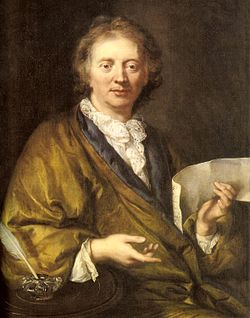 great composers who defined the French Baroque, born 32 years after Jean-Baptiste Lully and 15 years ahead of Jean-Philippe Rameau. Couperin came from a famous musical family: his uncle, Louis Couperin, was a noted composer and the organist at the church of St-Gervais in central Paris. After Louis’s death, François’s father Charles assumed the post. François’s father died in in 1679; the young François was so promising and obviously talented that the church agreed to hire him as the organist on his 18th birthday. In the interim, François played there often and was practically a full-time organist at St-Gervais even before his official appointment. At the age of 20 François married a girl from a wealthy bourgeois family; her connections helped him to acquire the royal privilege to print and sell his music. A year later Couperin published a collection of organ works, but it was his fame as an organist that brought him to the attention of the court. In 1693, at the age of 25, he received a fabulous appointment as the organist to the court of Louis XIV. Around that time, he wrote a set of trio sonatas, which were later incorporated into a larger selection published under the title of Les nations. The sonatas were clearly modelled after asimilar set of trio sonatas by Arcangelo Corelli, who was Couperin’s favorite composer. As Couperin himself related later on in a preface to the publication, he indulged in a bit of subterfuge in order to promote his work. Knowing that the French were still enamored with all things Italian while looking down at local composers, he concocted a story about an Italian origin of the first sonata. He even made up an Italianate name of the “composer” by rearranging letters of his own name. The sonata was received very favorably, which encouraged Couperin to continue composing.
great composers who defined the French Baroque, born 32 years after Jean-Baptiste Lully and 15 years ahead of Jean-Philippe Rameau. Couperin came from a famous musical family: his uncle, Louis Couperin, was a noted composer and the organist at the church of St-Gervais in central Paris. After Louis’s death, François’s father Charles assumed the post. François’s father died in in 1679; the young François was so promising and obviously talented that the church agreed to hire him as the organist on his 18th birthday. In the interim, François played there often and was practically a full-time organist at St-Gervais even before his official appointment. At the age of 20 François married a girl from a wealthy bourgeois family; her connections helped him to acquire the royal privilege to print and sell his music. A year later Couperin published a collection of organ works, but it was his fame as an organist that brought him to the attention of the court. In 1693, at the age of 25, he received a fabulous appointment as the organist to the court of Louis XIV. Around that time, he wrote a set of trio sonatas, which were later incorporated into a larger selection published under the title of Les nations. The sonatas were clearly modelled after asimilar set of trio sonatas by Arcangelo Corelli, who was Couperin’s favorite composer. As Couperin himself related later on in a preface to the publication, he indulged in a bit of subterfuge in order to promote his work. Knowing that the French were still enamored with all things Italian while looking down at local composers, he concocted a story about an Italian origin of the first sonata. He even made up an Italianate name of the “composer” by rearranging letters of his own name. The sonata was received very favorably, which encouraged Couperin to continue composing.
In addition to the position of the Royal organist, Couperin was appointed the harpsichordist to the court. He also continued to work at the church of St-Gervais. He had many students, most from noble families. And still he found time to compose. In 1713 he published the first book of harpsichord pieces; eventually he would publish three more. In 1715 Louis XIV died and was succeed by the regency, as Louis XV, the future king, was too young to rule. Couperin retained his position at the court and continued with all his commitments and composing. By his contemporaries he was considered probably the greatest composer of his generation, and clearly the best composer for the harpsichord. Couperin became less productive in the last years of his life as his health was failing him. He died on September 11th of 1733. Couperin wrote in many genres: instrumental chamber music, music for the organ, some vocal music, but he excelled above all at composing for the harpsichord.
<Couperin inspired many composers, none more than Richard Strauss, who wrote not one but two symphonic pieces after Couperin’s harpsichord pieces. Let’s listen to several of the originals and then the Divertimento by Richard Strauss. First, the three pieces by Couperin: La Visionnaire, performed by Blandine Rannou, Musétes de Choisi et de Taverni, performed by Lionel Party, and Le tic-toc-choc, ou Les maillotins, played by Jory Vinocur. And here’s how Strauss adapted them for the orchestra. The Tokyo Metropolitan Symphony Orchestra is conducted by Hirogi Wakasugi.Permalink
October 31, 2016. Bellini and Sweelinck. Vincenzo Bellini was born on October 3rd of 1801 in Catania, Sicily. We don’t write about opera composers very often, opera being a stepchild at Classical Connect;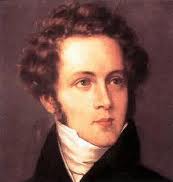 the reasons are purely technical, we do love a good opera. Even though Bellini lived for just 33 years he managed to create several masterpieces that belong to the pantheon of operatic art and have been continuously performed throughout the past 200 years. It’s interesting to note that at the beginning of the 19th century, before Rossini, Bellini and Donizetti produced their major works, Italian opera and composing in general, were not doing well. Opera was born in Italy, and for a century (the 17th, to be exact) Italians were by far the major innovators, even if we consider the talents of Lully, an Italian working in France, and Rameau, the first truly French opera composer. Things changed with George Frideric Handel, a German who absorbed the Italian tradition of Opera Seria and became (in England, of all the places) the major opera composer of his generation. Things shifted to Germany completely by the mid-18th century, with Gluck and especially, Mozart, producing masterpieces above anything else written in the genre. So, when in 1813, Rossini came up with his first major success, L'italiana in Algeri, and then, three years later, created Il barbiere di Siviglia, that ended a drought that lasted for almost 100 years. And in the following 20 years, between the three of them, Rossini, Donizetti and Bellini changed opera completely, producing works that sustain it even today. Bellini was the youngest of the three and his life was the shortest but his contributions were great: Il pirate in 1827, I Capuleti e i Montecchi in1830, La sonnambula a year later, then, in the same 1831, the great Norma and finally I puritani, written in 1835 and premiered in Paris just months before Bellini’s death. In our library we have several Bellini samples but none from Il Pirata. It was written while Bellini was living Milan; the La Scala premier was a great success. Here’s the final scene. Maria Callas is Imogene; the recoding was made in 1958 when Callas was past her absolute prime. Still this is better than anything we can hear being performed these days. The Philharmonia orchestra is led by Nicola Rescigno.
the reasons are purely technical, we do love a good opera. Even though Bellini lived for just 33 years he managed to create several masterpieces that belong to the pantheon of operatic art and have been continuously performed throughout the past 200 years. It’s interesting to note that at the beginning of the 19th century, before Rossini, Bellini and Donizetti produced their major works, Italian opera and composing in general, were not doing well. Opera was born in Italy, and for a century (the 17th, to be exact) Italians were by far the major innovators, even if we consider the talents of Lully, an Italian working in France, and Rameau, the first truly French opera composer. Things changed with George Frideric Handel, a German who absorbed the Italian tradition of Opera Seria and became (in England, of all the places) the major opera composer of his generation. Things shifted to Germany completely by the mid-18th century, with Gluck and especially, Mozart, producing masterpieces above anything else written in the genre. So, when in 1813, Rossini came up with his first major success, L'italiana in Algeri, and then, three years later, created Il barbiere di Siviglia, that ended a drought that lasted for almost 100 years. And in the following 20 years, between the three of them, Rossini, Donizetti and Bellini changed opera completely, producing works that sustain it even today. Bellini was the youngest of the three and his life was the shortest but his contributions were great: Il pirate in 1827, I Capuleti e i Montecchi in1830, La sonnambula a year later, then, in the same 1831, the great Norma and finally I puritani, written in 1835 and premiered in Paris just months before Bellini’s death. In our library we have several Bellini samples but none from Il Pirata. It was written while Bellini was living Milan; the La Scala premier was a great success. Here’s the final scene. Maria Callas is Imogene; the recoding was made in 1958 when Callas was past her absolute prime. Still this is better than anything we can hear being performed these days. The Philharmonia orchestra is led by Nicola Rescigno.
Jan Pieterszoon Sweelinck is a Renaissance Dutch composer we’ve never written about, the only excuse being that we don’t know his birthday. Sweelinck was born in Deventer in 1562. Soon after, his family moved to Amsterdam where his father, Pieter, became an organist at Aude Kerk (Old Church), Amsterdam’s oldest building located in what is now Amsterdam’s red-light district. The church has the largest wooden vault in Europe, which creates wonderful acoustics. Pieter died in 1577 and the 15-year old Jan Pieterszoon took his place. He served as the organist at Aude Kerk for the rest of his uneventful life. Sweelinck had many pupils, who eventually became influential organists in the Netherlands and northern Germany. Even though he never travelled to Italy (one of the few major composers not to have done so) or anywhere else, he was clearly familiar with the contemporary Italian and English music. Sweelinck was famous for his improvisations: foreigners were brought to his church to hear him play. Sweelinck wrote many keyboard compositions, none of which, were printed during his lifetime. What was published in large numbers were his choral works. Curiously, none of the text are in Dutch – all are set in French. Here, for example, are his setting of Psalm 150 (Or soit loué l'Eternel) and Psalm 53 (Le fol malin). Both are performed by the Netherlands Chamber Choir under the direction of Peter Phillips.
PermalinkOctober 24, 2016. From Scarlatti to Berio. Four wonderful composers were born this week, three Italians and one Frenchman. Domenico Scarlatti, one of our all-time favorites, was born on October 26th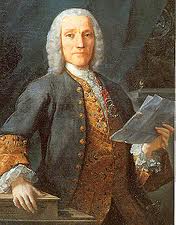 of 1685 in Naples. He probably studied music with his father, Alessandro Scarlatti, a famous opera composer. These days we know Domenico as the author of 555 clavier sonatas, most written while Scarlatti was serving at the courts of Spain and Portugal, but very few of them were published during his lifetime. His first publication, 30 Essercizi didn’t happen till 1738. The “exercises” are actually sonatas, which were later catalogued under different numbers, first by Alessandro Longo at the beginning of the 20th century, then later, by Ralph Kirkpatrick and others. Here’s the very first sonata in this cycle, Sonata in d Minor, K 1/L 366. It’s performed by Vladimir Bakk, a talented pianist, forgotten in his homeland, whose career never took off in his adopted country. Bakk was born in Moscow in 1944. He studied at the Moscow Conservatory with Yakov Zak, a famous pianist and pedagogue. In 1972 he won the Montevideo piano competition, and made several recordings with Melodia. It’s not clear what happened but at some point he fell into disfavor with Philharmonia, the main concert organization: he was banned from playing abroad and even in the larger cities of the Soviet Union (the retelling of his concert in a small town of Uralsk is hilarious and sad at the same time). The circumstances are not clear, but he was imprisoned twice. Bakk emigrated to Israel in 1990 and moved to the United States two years later. Even though his playing was lauded by the likes of Vladimir Horowitz, Martha Argerich and Vladimir Feltsman, his career never took off. He died in 2007. You can judge the quality of Bakk’s playing for yourself with this little jewel of Scarlatti.
of 1685 in Naples. He probably studied music with his father, Alessandro Scarlatti, a famous opera composer. These days we know Domenico as the author of 555 clavier sonatas, most written while Scarlatti was serving at the courts of Spain and Portugal, but very few of them were published during his lifetime. His first publication, 30 Essercizi didn’t happen till 1738. The “exercises” are actually sonatas, which were later catalogued under different numbers, first by Alessandro Longo at the beginning of the 20th century, then later, by Ralph Kirkpatrick and others. Here’s the very first sonata in this cycle, Sonata in d Minor, K 1/L 366. It’s performed by Vladimir Bakk, a talented pianist, forgotten in his homeland, whose career never took off in his adopted country. Bakk was born in Moscow in 1944. He studied at the Moscow Conservatory with Yakov Zak, a famous pianist and pedagogue. In 1972 he won the Montevideo piano competition, and made several recordings with Melodia. It’s not clear what happened but at some point he fell into disfavor with Philharmonia, the main concert organization: he was banned from playing abroad and even in the larger cities of the Soviet Union (the retelling of his concert in a small town of Uralsk is hilarious and sad at the same time). The circumstances are not clear, but he was imprisoned twice. Bakk emigrated to Israel in 1990 and moved to the United States two years later. Even though his playing was lauded by the likes of Vladimir Horowitz, Martha Argerich and Vladimir Feltsman, his career never took off. He died in 2007. You can judge the quality of Bakk’s playing for yourself with this little jewel of Scarlatti.
Niccolò Paganini, the great Italian violinist, was born on October 27th of 1782 in Genoa. His best known composition is a cycle of 24 Caprices, which were written between 1802 and 1817. Each Caprice is a devilishly difficult etude, emphasizing certain technical aspect of violin playing. Here is Salvatore Accardo, one of the greatest interpreters of Paganini’s music, playing Caprice no. 3 in e minor, “Octaves.”
Georges Bizet never gets enough attention from us. An opera composer, he’s mostly famous for Carmen, which was premiered three months before Bizet’s untimely death (he was only 37). The premier was panned by the critics, and the next performance, after Bizet’s death, was lauded by the same. Bizet was married to Geneviève, daughter of the composer and Bizet’s teacher Fromental Halévy. Geneviève, who outlived George by half a century and later opened a salon popular with nobility, politicians and literary figures, was one of the models for Marcel Proust’s Duchesse de Guermantes (the main inspiration for the character, Comtesse Greffulhe, frequented Geneviève’s salon). George and Geneviève had a son, Jacques, a close friend of Proust’s. In addition to operas, Bizet wrote some piano music; here’s his Jeux d'enfants (Children's Games) for piano four hands. It’s performed by Amy and Sara Hamann.
Luciano Berio, one of the most interesting composers of the second half of the 20th century, was born on October 24th of 1925. We wrote about him here and, without a doubt, will do so again.Permalink
October 17, 2016. Liszt and Marenzio. Several composers were born this week. The most famous of them is Franz Liszt, born on October 22nd of 1811. We love him, despite his somewhat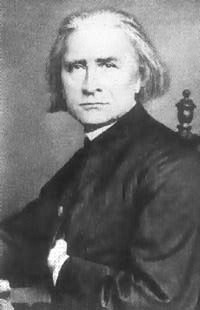 diminished reputation (these days he’s performed less frequently than, for example, in the mid-20th century). We’ve written about him many times, even publishing several short articles on his piano cycle, Années de Pèlerinage. So this time we’ll just play some of his music – Piano concerto no. 1, for example. It’s said that Liszt composed the theme of the first movement in 1830, when he was 19, but completed the concerto almost 20 years later, in 1849. He premiered it six years later, in 1855, in Weimar, with an orchestra conducted by his good friend, Hector Berlioz. (Liszt, the greatest piano virtuoso of his – and probably of any – time, stopped concertizing around 1847, settling in Weimar, but still gave occasional performances). Here it is, in a brilliant, exhilarating performance by Sviatoslav Richter, with Kirill Kondrashin conducting the London Symphony orchestra. The recording was made in 1961.
diminished reputation (these days he’s performed less frequently than, for example, in the mid-20th century). We’ve written about him many times, even publishing several short articles on his piano cycle, Années de Pèlerinage. So this time we’ll just play some of his music – Piano concerto no. 1, for example. It’s said that Liszt composed the theme of the first movement in 1830, when he was 19, but completed the concerto almost 20 years later, in 1849. He premiered it six years later, in 1855, in Weimar, with an orchestra conducted by his good friend, Hector Berlioz. (Liszt, the greatest piano virtuoso of his – and probably of any – time, stopped concertizing around 1847, settling in Weimar, but still gave occasional performances). Here it is, in a brilliant, exhilarating performance by Sviatoslav Richter, with Kirill Kondrashin conducting the London Symphony orchestra. The recording was made in 1961.
Liszt is not the only composer born this week. We’ve never written about Luca Marenzio, an Italian Renaissance composer famous for his madrigals. Marenzio was born on October 18th of 1553, or at least that’s what the musicologists surmise. To place him within the timeline of Italian music, Marenzio was one year older than Giovanni Gabrieli and about eight years younger than Luzzasco Luzzaschi about whom we wrote just last week. Marenzio was born near Brescia in Northern Italy. When he was 25 years old, he was hired by Cardinal Luigi d’Este. The Cardinal was a son of Ercole II d'Este, Duke of Ferrara and Modena who in turn was the eldest son of Duke Alfonso I d'Este and the famous (or, rather, infamous) Lucrezia Borgia. Marenzio worked for the Cardinal as maestro di capella for eight years, till the Cardinal’s death. Luigi d’Este had two palaces in Rome and also maintained the enormous Villa d'Este, outside of Rome, which was built by his uncle, Cardinal Ippolito II d'Este (Ippolito, also a patron of arts, brought Palestrina to the Villa to take care of the music there). While in d’Este’s employ, Marenzio composed a large number of madrigals which were published not just in Italy but also in Antwerp, Nuremberg and London. Luigi d’Este died in 1586 but Marenzio stayed in Rome as a freelance composer. About a year later he entered the service of Cardinal Ferdinando de Medici, who soon after became the Grand Duke of Tuscany. Marenzio moved to Florence, where he stayed till 1589. Upon leaving Florence, he returned to Rome, where he had a number of patrons, including the Pope himself. The pope sent him on an unusual trip, to the court of the King of Poland, Sigismund III Vasa. Marenzio stayed in Warsaw for almost two years. He returned to Rome in 1598 and died soon after, age 45, on August 22nd of 1599. It’s somewhat of a mystery why Marenzio isn’t known better these days. The best of Marenzio’s madrigals are beautiful, full of wonderful, sometimes unusually chromatic sonorities. Here are three examples, Liquide perle amor from 1580, Bascami mille volte from 1585 and Et ella ancide, e non val c'huom si chiuda from 1599, the last year of his life; all three madrigals are for five voices, Marenzio’s preferred type. They are performed by Concerto Italiano conducted by Rinaldo Alessandrini.
Permalink
October 10, 2016. An Italian composer with an unusually sounding name, Luzzasco Luzzaschi, was born in Ferrara around 1545; he lived there practically all his life. Luzzaschi is probably more famous as a teacher and a keyboard player, but he was also a fine composer. He studied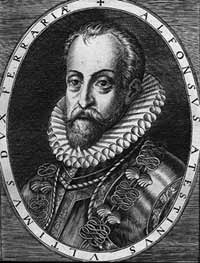 music and the organ, playing at an early age and became an organist at the court of the Duke Alfonso II d’Este at 16; he was promoted to the first organist at 19. During the second half of the 16th century, the court was a glorious place, Duke Alfonso being a major patron of arts. Luzzaschi remained the first organist for the rest of his career, but his duties were broadened: he composed, took charge of the court orchestra and trained young musicians (Ippolito Fiorini was formally the maestro di cappella at the court, but his duties seem to have been more administrative). Sometime around 1570 Luzzaschi took over the Duke’s chamber music concerts. The concerts were organized as “musica secreta” (secret music) for a small and very exclusive audience; the repertory of these concerts was kept secret, but it’s assumed that some of it was written by Luzzaschi himself. During these concerts, Luzzaschi usually played on a keyboard (by that time he was considered one of the finest keyboard players around); some instrumental music was performed as well, but the main attraction was a group of highly skilled women singers, called Concerto delle Donne. An ensemble of female voices was highly unusual for that time. The initial Concerto consisted of several very talented but amateur singers, but eventually professional ones were hired as well. By the 1580s Concerto started performing in public and their fame spread all over Italy. Apparently, every singer in the ensemble was a virtuoso, and there was no group of equal quality in all of the country; Luzzaschi has to be given credit as their music director. Much of the music performed by the Concerto was written by Luzzaschi, but they also performed madrigals written for them by Carlo Gesualdo, Lodovico Agostini and many other noted composers.
music and the organ, playing at an early age and became an organist at the court of the Duke Alfonso II d’Este at 16; he was promoted to the first organist at 19. During the second half of the 16th century, the court was a glorious place, Duke Alfonso being a major patron of arts. Luzzaschi remained the first organist for the rest of his career, but his duties were broadened: he composed, took charge of the court orchestra and trained young musicians (Ippolito Fiorini was formally the maestro di cappella at the court, but his duties seem to have been more administrative). Sometime around 1570 Luzzaschi took over the Duke’s chamber music concerts. The concerts were organized as “musica secreta” (secret music) for a small and very exclusive audience; the repertory of these concerts was kept secret, but it’s assumed that some of it was written by Luzzaschi himself. During these concerts, Luzzaschi usually played on a keyboard (by that time he was considered one of the finest keyboard players around); some instrumental music was performed as well, but the main attraction was a group of highly skilled women singers, called Concerto delle Donne. An ensemble of female voices was highly unusual for that time. The initial Concerto consisted of several very talented but amateur singers, but eventually professional ones were hired as well. By the 1580s Concerto started performing in public and their fame spread all over Italy. Apparently, every singer in the ensemble was a virtuoso, and there was no group of equal quality in all of the country; Luzzaschi has to be given credit as their music director. Much of the music performed by the Concerto was written by Luzzaschi, but they also performed madrigals written for them by Carlo Gesualdo, Lodovico Agostini and many other noted composers.
Luzzaschi was also famed as a teacher and mentor. Frescobaldi studied with him; it’s said that Gesualdo, who went to Ferrara to marry the Duke's niece, Leonora d'Este, was mostly interested in meeting Luzzaschi (on that occasion, Gesualdo wrote several canzoni for the Concerto delle Donne). Many composers of the Roman School also studied with Luzzaschi. Things changed considerably after Duke Alfonso’s death in 1597. The Duke didn’t leave any heirs, whether legitimate or not. Alfonso’s cousin, Cesare d'Este, took over, but this succession wasn’t recognized by the Pope. A year later Ferrara was incorporated into the Papal States, so Cesare and the court moved to Modena. To run the government, the Pope appointed a legate, Cardinal Pietro Aldobrandini. Luzzaschi stayed in Ferrara and joined the Cardinal’s retinue; in 1601 he accompanied the Cardinal on a trip to Rome. On that occasion, he arranged for the printing of a book of his madrigals.
Luzzaschi died in Ferrara on September 10th of 1607. Here are two madrigals by Luzzaschi, T'amo mia vita and Cor mio, deh non languire. They are performed by Consort of Musicke under the direction of Anthony Rooley.Permalink